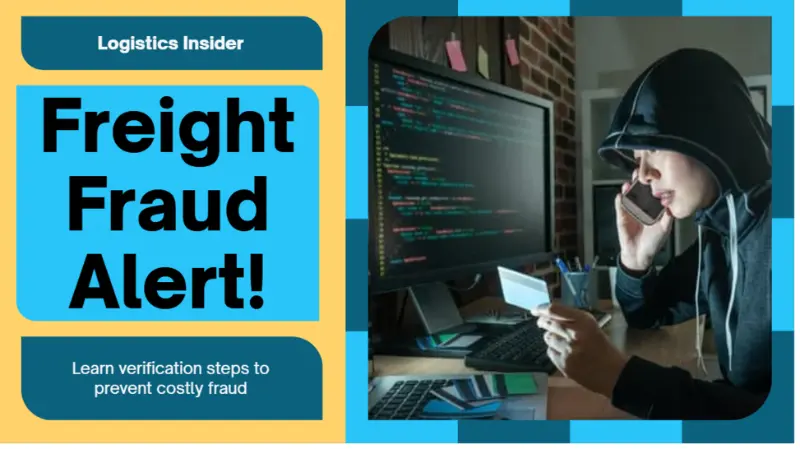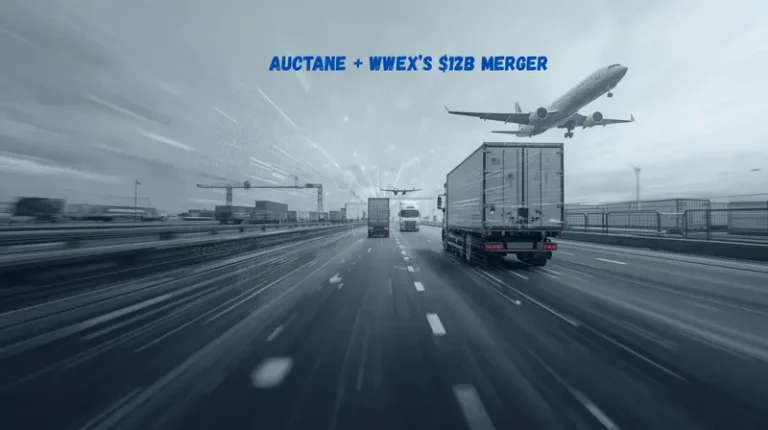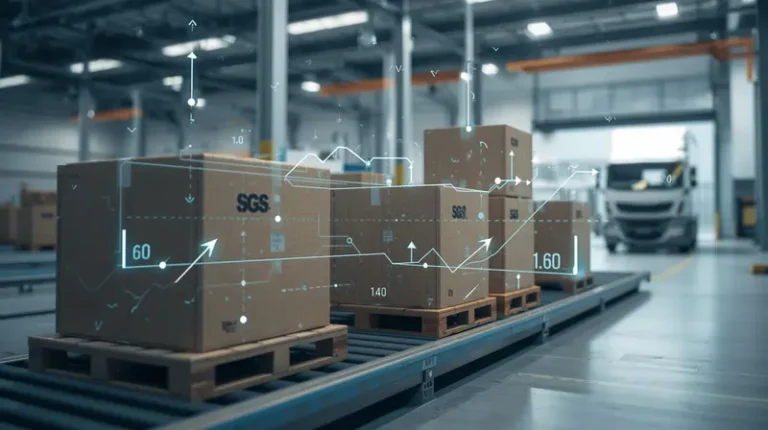Freight Fraud: Why Logistics Professionals Need to Stay Vigilant

Last updated on August 26, 2025

In this article
 9 minutes
9 minutes
- The Freight Industry’s New Risk Math
- How The Most Common Scams Really Work (And Where Teams Trip)
- What I’d Implement Tomorrow If I Owned Your Brokerage (Or Fleet)
- Why The Fraud Curve Keeps Rising (And How To Bend It)
- Tools And Practices I Trust (And How I Deploy Them)
- What To Update In Your Contracts
- The Bottom Line
- Frequently Asked Questions
Freight fraud isn’t one scam; it’s a whole category of criminal business models feeding on a hyper-competitive, digitized freight industry. I’m talking identity theft of legitimate carriers, double brokering that ends in non-payment, fake profiles on load boards, and cargo theft that disappears shipments and dollars annually. If you touch loads, broker, carrier, or shipper, you’re in the blast radius.
I run logistics with a simple rule: assume bad actors are probing your systems every week. Not because you’re special, but because the freight industry itself is a target-rich environment. Fragmented systems, undertrained teams, pressure to cover loads now, and lots of sensitive information moving through email. That’s catnip for fraudsters.
Slash Your Fulfillment Costs by Up to 30%
Cut shipping expenses by 30% and boost profit with Cahoot's AI-optimized fulfillment services and modern tech —no overheads and no humans required!
I'm Interested in Saving Time and MoneyThe Freight Industry’s New Risk Math
Everyone feels the squeeze: rates down, fuel up, customers impatient. Hyper-competition creates more opportunities for shortcuts. Shortcuts create more openings for fraud. The logistics industry isn’t dealing with one-off incidents anymore; we’re living with a persistent threat where sophisticated schemes evolve faster than most companies update their practices.
Let’s call it what it is: freight fraud costs are rising, and the fraudsters are getting bolder. Double brokering, payment fraud, cargo theft, and identity theft now show up in various forms, compromised login credentials, spoofed emails, sold or stolen MC numbers, counterfeit COIs, cloned carrier websites, and even deepfaked voices on “verification” calls. The logistics sector’s old playbook, trust the paperwork, move the load, no longer maps to reality.
How The Most Common Scams Really Work (And Where Teams Trip)
1. Double brokering that turns into non-payment
A re-broker posts a fake or hijacked load, books a real carrier, and either never pays the carrier or swaps in a ghost carrier midstream. You’ll see mismatched domains, urgent tone, vague driver information, and last-minute banking changes. Freight brokers fall when the verification process is rushed or when one person is allowed to override policy “this one time.”
2. Carrier identity theft and fake profiles
Fraudsters impersonate legitimate carriers, sometimes with real DOT/MC details and a cloned website. They’ll provide doctored insurance and driver info, then vanish after pickup. Tell-tale signs: phone numbers that don’t match official listings, Gmail addresses on “legitimate carriers,” and COIs that don’t verify with the insurer.
3. Cargo theft with clean paperwork
Organized groups use social engineering to become the real broker on paper, then redirect a shipment to a shell yard. Legitimate carriers get stuck in the middle, shippers blame “the broker,” and recovery becomes a long shot. Metals, consumer electronics, food and beverage, apparel, high-value, easy-to-fence categories are red hot again.
4. Payment fraud that drains financial stability
BEC-style email compromises reroute payments. Fraudsters slip into threads, swap ACH details, and collect. If your AP team isn’t verifying identities with out-of-band call-backs, your “real broker” might be paying the wrong account for months.
Looking for a New 3PL? Start with this Free RFP Template
Cut weeks off your selection process. Avoid pitfalls. Get the only 3PL RFP checklist built for ecommerce brands, absolutely free.
Get My Free 3PL RFPWhat I’d Implement Tomorrow If I Owned Your Brokerage (Or Fleet)
This isn’t theory. It’s a practical verification process that protects operations without killing speed. Train employees; write it down; audit it monthly.
Looking for a New 3PL? Start with this Free RFP Template
Cut weeks off your selection process. Avoid pitfalls. Get the only 3PL RFP checklist built for ecommerce brands, absolutely free.
Get My Free 3PL RFP1. Identity and intent verification (every new partner, every time)
- Verify carrier identity from official sources, not the email signature. Use FMCSA SAFER, the carrier’s own website, and insurer call-backs to numbers you locate, not numbers they provide.
- Require real-time photo ID for the driver and dispatcher on video. Keep the call recording with the load file.
- Confirm COI straight with the insurance agent, not a PDF attachment. No exceptions.
- If the email domain is generic (Gmail, Yahoo), treat it as high risk even if everything “checks out.”
2. Dedicate one person to kill switches
- No last-minute banking or payment changes without an out-of-band phone verification to a known number on file.
- Suspend credit immediately if a partner refuses insurance verification or won’t do a quick video handshake.
- Lock payment terms until a first successful shipment clears without incident.
3. Secure your systems like you secure your yard
- MFA everywhere: TMS, load boards, factoring portals, email, cloud storage. If a login doesn’t support MFA (Multi-Factor Authentication), replace it.
- Restrict who can view full load details. Use role-based access so a compromised seat can’t harvest your entire book.
- Monitor for exposed credentials. If a password shows up in a breach, rotate immediately and re-train the user.
- Backstop with an allowlist of company-approved tools. No rogue spreadsheets with driver information on personal devices.
4. Tighten the load board workflow
- Build a “trust tier” for carriers, legitimate carriers you’ve vetted get first look at freight. New or unverified carriers go through the long-form checklist every time.
- Use watchlists and industry networks to screen for known bad actors. Share your own intel back to the network.
- Hide certain sensitive information in initial posts. Reveal pickup location and shipper name only after verification.
5. Pick up security measures at the dock
- Two-factor pickup: photo ID matches the driver’s info on file, and the truck’s plate matches what dispatch provided earlier.
- Geofence the pickup and capture a geo-tagged arrival photo in your app.
- Use one-time PINs at handoff. Record BOL photos and seal numbers in the app; require the driver to sign digitally.
- Train warehouse staff on scripts and escalation. If anything smells wrong, the shipment waits. Period.
6. Payment controls that actually prevent loss
- Micro-deposit verification for new bank accounts and changes to vendor records.
- Segregate duties: the person who verifies bank changes is not the person who releases payments.
- Factor with visibility. If you factor, require that your factor run separate fraud checks on re-brokers and carriers.
7. Tabletop drills and train employees quarterly
- Run 60-minute fraud drills every quarter: fake COI, spoofed phone, urgent re-route request. Measure time-to-catch.
- Post a one-page “what to do if you suspect fraud” near every ops seat and warehouse desk.
- Celebrate the catches; don’t shame false positives. The goal is culture: stay vigilant.
Why The Fraud Curve Keeps Rising (And How To Bend It)
First, the logistics industry has gone fully digital, but most companies still work like it’s 2015. Multiple sites, remote teams, and outsourced partners create more seams for fraudsters to pry open. Second, identity makes or breaks almost every scheme. If you get good at verifying identities, people, companies, and vehicles, you defang most fraudulent activities before they start. Third, speed pressure. When the supply chain is tight and customer SLAs are aggressive, a fake “carrier with a truck nearby” looks like a gift. That urgency is the weapon.
The counterplay isn’t fancy. It’s repeatable verification, security measures that are boring on purpose, and an operations culture that rewards caution. Industry networks help too. When brokers and carriers share signals, bad phone numbers, fake profiles, and stolen driver information, the whole community gets harder to crack. I’ll always choose a slightly slower start to a shipment over paying for a stolen load later.
Tools And Practices I Trust (And How I Deploy Them)
- Identity-centric platforms: Tools that cross-check DOT/MC, insurance, safety, equipment, and contact footprints help spot anomalies fast. Use them to flag identity theft and double brokering in real time.
- Risk dashboards: Cargo theft heat maps and alerts inform pickup scheduling, route choices, and parking policies. Think night pickups, high-value corridors, and urban pinch points.
- Device-based tracking: For sensitive shipments, add a breadcrumb, IoT trackers that phone home if a seal breaks or a trailer detours.
- Payment monitoring: Set rules that flag payments to newly created vendors or accounts changed this week.
- Annual security reviews: Audit your verification process, contracts, and training every year; refresh your playbook as schemes evolve.
Scale Faster with the World’s First Peer-to-Peer Fulfillment Network
Tap into a nationwide network of high-performance partner warehouses — expand capacity, cut shipping costs, and reach customers 1–2 days faster.
Explore Fulfillment NetworkWhat To Update In Your Contracts
- Clear language that prohibits re-brokering without written consent; define “unlawful brokerage” and spell out remedies.
- Explicit requirements for driver verification, equipment photos, and geofenced check-ins at pickup and drop.
- COI verification requirements (direct with insurer) and minimum limits by commodity.
- A right to withhold payment pending investigation if identity or paperwork is suspect.
- Data handling and privacy clauses so sensitive information isn’t scattered across freelancers and random portals.
The Bottom Line
Freight fraud is a logistics industry problem, not a single-department issue. If you’re a broker, you’re steering risk on every tender. If you’re a carrier, you’re a target for identity theft and non-payment. If you’re a shipper, your supply chain and financial stability ride on how well your partners verify identities and protect shipments. This isn’t about being paranoid; it’s about being professional.
One last thing. None of this works if leadership treats fraud like an ops headache. It’s a business risk. Train employees; fund the tools; make “verify first” the default. You’ll protect your carriers and your shippers, because you’ll show up as the real broker, the one that pays, the one that ships, the one that protects the load.
Frequently Asked Questions
What’s the single fastest way to cut freight fraud risk this quarter?
Put a hard stop on any banking change, COI swap, or pickup reroute without an out-of-band call-back to a known number on file. One policy change, massive impact.
How do I verify a legitimate carrier without slowing down?
Use a verification workflow: FMCSA/SAFER check, direct insurer call-back, video handshake with the dispatcher, and a quick driver ID match. Do it once, then tier your partners so legitimate carriers move fast on future loads.
What should warehouse staff look for at pickup?
License plate and driver ID must match your file; seal and BOL photos captured in your app; one-time PIN used at handoff; no “my boss said change the address” moves. If something feels off, the shipment does not leave.
Are load boards still safe to use?
Yes, with guardrails. Hide sensitive information up front, screen carriers through your identity tools, and use watchlists to spot re-brokers and fake profiles. Treat open boards as top-of-funnel, not as your verification system.
How do I keep my team from falling victim to BEC and payment fraud?
MFA on email and finance systems; train AP to validate account changes with voice verification to a known number; run monthly reports of “new vendor, new bank” and review them. No screenshots as proof. Only call-backs.
What freight tools or networks should I use or join?
Join the industry networks that share fraud intel and theft alerts; use risk dashboards for route and parking decisions; consider identity-centric platforms for real-time verification. The mix matters less than the habit of checking.
What should my customers hear from me about freight security?
Explain your verification process, your preventative measures, and how you protect sensitive information. It builds trust, and it wins freight.

Turn Returns Into New Revenue





